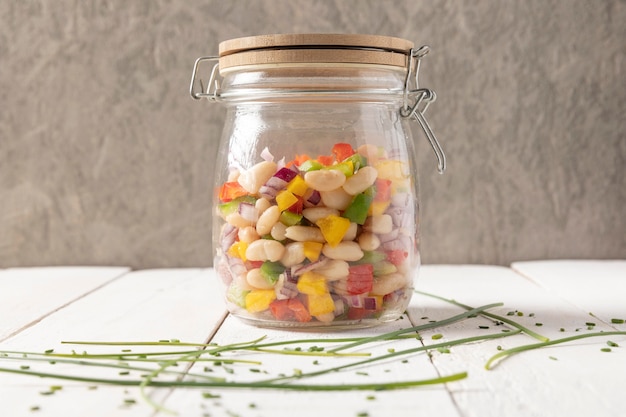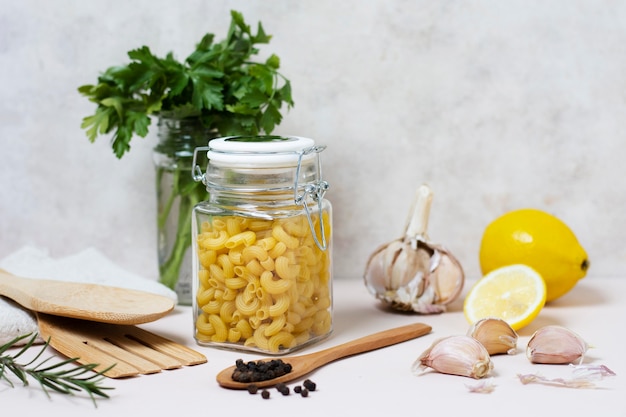It’s a question that has probably crossed your mind at least once: can you really eat canned corn straight from the can? After all, it’s already been processed, right? I've found myself debating this with my mum countless times. She swears by the idea of canned corn being ready to eat, often grabbing a handful straight from the can. Me, on the other hand? I’m a bit more cautious, my inner voice screaming "It’s in a can! It needs cooking!"
So, let's dive into the world of canned corn and see what the truth is. We’ll explore the safety of eating it raw, the best ways to cook it, and even discover some alternatives that might just make you forget about canned corn altogether!
(Part 1) Unveiling the Canned Corn Enigma

You might be surprised to learn that canned corn is, in fact, already cooked. The process involves a technique called blanching, where the corn is quickly heated to deactivate enzymes and preserve its colour and flavour. After blanching, it’s packed into cans and heated again under pressure to eliminate any remaining bacteria. So, in theory, it's safe to eat straight out of the can.
The Can's Tale: A Closer Look
However, even though it's technically safe, the question of whether it's palatable or even desirable is a whole other story. Canned corn often has a somewhat mushy texture and a blander flavour compared to fresh or frozen corn. And while the canning process does kill off most bacteria, there’s always a chance some might survive. This is why it’s crucial to check the can before opening it.
If you see any dents, bulges, or rust on the can, it's best to discard it, as these could indicate contamination. Additionally, canned corn is typically packed in a salty brine or a sugary syrup, which can be high in sodium and sugar. It’s not exactly the healthiest snack option!
(Part 2) Beyond the Can: The Art of Cooking Canned Corn

I'm a firm believer in enhancing the flavour of canned corn. Think of it as a blank canvas, ready for your culinary creativity to work its magic. Cooking canned corn can bring out its natural sweetness, add some texture, and transform it into a far more enjoyable experience.
Simple Sautee: A Quick and Easy Solution
My go-to method is a simple saute. Just heat a little butter or olive oil in a pan, toss in the corn, and cook for a few minutes until it’s heated through. You can spice things up with a sprinkle of chili powder, paprika, or cumin. This method is perfect for adding corn to stir-fries, salads, or even as a simple side dish.
The Flavorful Bake: A Treat for Your Taste Buds
For a more indulgent option, try baking your canned corn. Combine it with cream, cheese, and your favourite seasonings, then bake until it’s bubbly and golden brown. This is a delightful topping for tacos, burritos, or a side dish for grilled meats.
A World of Possibilities: Getting Creative with Corn
Don't be afraid to experiment! Canned corn can be incorporated into a variety of dishes. Add it to soups, stews, pasta dishes, or even use it in a cornbread recipe. The possibilities are endless!
(Part 3) Understanding the Spectrum of Canned Corn

Canned corn isn't just one type of product. There are various options available, each with its own unique characteristics.
Whole Kernel Corn: The Classic Choice
This is the most common type of canned corn. It consists of whole kernels packed in a brine or syrup. It’s versatile and can be used in a wide range of recipes.
Creamed Corn: A Smooth and Creamy Option
Creamed corn has a smoother texture due to being blended with milk, cream, and sometimes butter. It’s often used in soups, casseroles, or as a side dish.
sweet corn: For Dessert Lovers
Sweet corn is packed in a sugary syrup, resulting in a sweeter taste. It’s often used in desserts or as a topping for ice cream.
Organic Corn: A Healthier Option
Organic corn is grown without the use of synthetic pesticides or fertilizers, making it a healthier choice. It’s usually more expensive than conventionally grown corn.
(Part 4) Canned Corn: A Pantry Staple or a Rare Treat?
Canned corn is certainly a convenient pantry staple for busy weeknights when you need a quick and easy meal. It’s affordable, widely available, and has a long shelf life. However, it’s not always the healthiest option, and it's not the best substitute for fresh or frozen corn.
Here’s a quick comparison table to help you weigh your options:
| Factor | fresh corn | Canned Corn | Frozen Corn |
|---|---|---|---|
| Taste | Sweet, juicy, fresh | Slightly bland, can be mushy | Sweet, fresh flavour, retains texture |
| Nutrition | Higher in vitamins and minerals | Lower in nutrients, higher in sodium | Close to fresh corn in nutrition |
| Cost | More expensive | More affordable | Mid-range in price |
| Availability | Seasonal | Year-round | Year-round |
| Shelf life | Short | Long | Long |
(Part 5) The Verdict: Canned Corn, Cooked or Uncooked?
So, can you eat canned corn straight from the can? The answer is yes, it’s safe. But, it’s not the most delicious or nutritious choice. It lacks the flavour and texture of cooked corn. My advice is to cook it if you have time. It’ll taste much better, and you can explore various flavours and textures. But, if you’re in a pinch, a small serving of canned corn won’t harm you. Just try not to make it a regular habit.
(Part 6) Expanding Your Corn Horizons: Exploring Alternatives
The world of corn offers more than just canned corn! If you’re looking for a healthier and more flavourful alternative, consider exploring these options:
Frozen Corn: A Convenient and Delicious Choice
Frozen corn is often picked at peak ripeness and frozen quickly to preserve its freshness. It’s also lower in sodium and sugar than canned corn. You can use frozen corn in most recipes that call for canned corn.
Fresh Corn: The Ultimate Corn Experience
Fresh corn on the cob is a true delight. It’s sweet, juicy, and bursting with flavour. You can grill, boil, roast, or even eat it raw. Fresh corn is a real treat, especially when it’s in season.
Cornmeal: A Versatile Ingredient
Cornmeal is a versatile ingredient that can be used in a variety of recipes. From cornbread and pancakes to polenta and fritters, cornmeal adds a nutty flavour to your dishes and is a good source of fibre.
(Part 7) The Corn Craze: Beyond the Ordinary
Beyond the usual, there’s a whole world of corn waiting to be explored! It’s time to break free from the ordinary and embrace some exciting corn-based possibilities.
Popcorn: A Beloved Snack
Popcorn is a popular snack, perfect for movie nights or casual gatherings. It’s a surprisingly healthy snack, packed with fibre and antioxidants. Experiment with different flavours, from classic butter and salt to spicy or cheesy.
Cornbread: A Southern Delight
Cornbread is a classic Southern staple that’s perfect for breakfast, brunch, or dinner. It’s moist, crumbly, and slightly sweet. You can enjoy it plain or top it with honey, butter, or your favourite toppings.
Corn Chowder: A Comforting Soup
Corn chowder is a creamy and comforting soup perfect for cold weather. It’s made with potatoes, corn, and often bacon or ham. Add a touch of spice with a pinch of chili powder or cayenne pepper.
Corn Fritters: A Crispy Treat
Corn fritters are a delicious and crispy appetizer or side dish. They’re made with cornmeal, corn kernels, and often cheese or herbs. They’re perfect for dipping in sour cream or ranch dressing.
FAQs
1. Can you eat canned corn straight from the can?
You can eat canned corn straight from the can, but it’s not the most appealing or nutritious way to eat it. Canned corn often has a mushy texture and a bland taste. Cooking it can bring out its natural sweetness and flavour.
2. Is canned corn safe to eat?
Canned corn is generally safe to eat if the can is not dented, bulging, or rusty. The canning process involves heating the corn to kill off bacteria, making it safe for consumption. However, it's always best to check the can before opening it and discard any cans that appear damaged.
3. What are the health benefits of canned corn?
Canned corn is a good source of fibre, potassium, and vitamin C. However, it’s also high in sodium and sugar, so it’s not the healthiest choice if you’re watching your intake of these nutrients.
4. What are some healthy alternatives to canned corn?
Frozen corn, fresh corn, and cornmeal are all healthier alternatives to canned corn. Frozen corn is a convenient and nutritious option, while fresh corn is the best choice for taste and flavour. Cornmeal is a versatile ingredient that can be used in a variety of recipes.
5. How can I cook canned corn?
Canned corn can be cooked in a variety of ways. You can sautee it, bake it, add it to soups, stews, or pasta dishes, or use it in a cornbread recipe. Get creative and experiment with different flavours and textures.
So, there you have it – a comprehensive guide to the world of canned corn. Whether you eat it straight from the can, cook it up, or choose another corn option, I hope you’ve gained some useful insights. Remember, the world of corn is your oyster – go forth and explore!
Everyone is watching

How to Cook Frozen Lobster Tails Perfectly: A Step-by-Step Guide
RecipesLobster. Just the word conjures up images of lavish meals, special occasions, and a taste of luxury. But let's...

Pigs in a Blanket Cooking Time: How Long to Bake for Perfect Results
RecipesAh, pigs in a blanket. Just the name conjures up images of those delightful little parcels of crispy pastry en...

Pork Fillet Cooking Time: How Long to Cook It Perfectly
RecipesPork fillet, or tenderloin as it's sometimes called, is a real favourite in our house. It's so versatile, and...

The Ultimate Guide to Cooking Delicious Frankfurters
RecipesLet's face it, we all love a good frankfurter. It's a classic, simple, and always satisfying. But let's be rea...

Wolf Meat Recipes: A Guide to Cooking Wild Game
RecipesLet's be honest, you don't see wolf meat at your local butcher shop every day. It's a bit of a wild card, but ...
